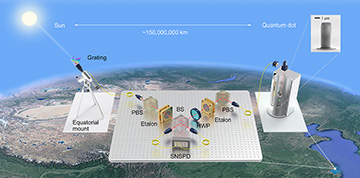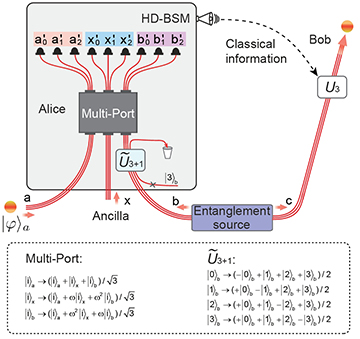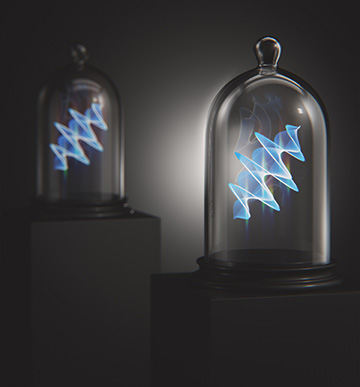
Experiments led by researchers at the University of Science and Technology of China (USTC) and other institutions achieved teleportation of 3-D quantum information and interference of photons from sources 150 million km apart. [Image: R. Zhou/USTC, courtesy of C.-Y. Lu]
The quantum world is an almost proverbially strange place. It’s characterized by such oddities as the entanglement of widely separated particles, the superposition of multiple possible realities on a single particle at the same time, and even the disembodied “teleportation” of one particle’s quantum state onto another, distant particle. Yet these seemingly exotic phenomena together make up the toolkit now being used to build future quantum technology.
As physicists have honed the techniques for demonstrating these phenomena in the lab, such observations—once labeled “quantum weirdness”—have begun to look almost routine. Two remarkable recent experiments from scientists at the University of Science and Technology of China (USTC) and other institutions, however, offer a reminder that the basic study of quantum phenomena still has surprises in store.
In one study, the researchers achieved quantum interference and entanglement between single photons carefully generated in the lab, and the very different, uncontrolled stream of photons born 150 million km away in the hot, undisciplined mess of the sun (Phys. Rev. Lett., doi: 10.1103/PhysRevLett.123.080401). And a second study demonstrated the teleportation of a 3-D entangled quantum state—a “qutrit”—from one light particle to another, a feat heretofore limited to 2-D quantum objects, or qubits (Phys. Rev. Lett., doi: 10.1103/PhysRevLett.123.070505).
Both experiments expand the possibilities for advanced quantum technologies, particularly in communications and encryption—while also opening up intriguing avenues of investigation in quantum optics and even deep-space astrophysics.
Quantum of Sol
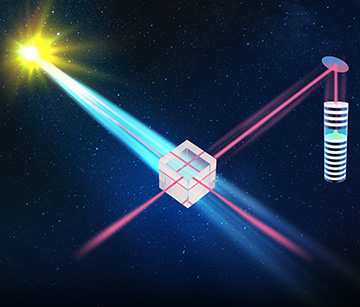
[Image: C.-Y. Lu and L.-C. Peng/HFNL, courtesy of C.-Y. Lu]
The study involving the quantum interference of solar and lab-created photons rests on the so-called Hong-Ou-Mandel (HOM) effect. When two “quantum-mechanically indistinguishable” photons enter a beam splitter at precisely the same time, they will tend to bunch together, and exit through the same arm of the beam splitter at a probability of much greater than 50%, rather than each being routed through one of the two arms separately with equal probability.
Since its discovery more than three decades ago, this quantum-interference effect has been replicated many times with independent photons in the lab. Indeed, it’s a key test for the indistinguishability of single photons for quantum experiments and technology (see “Single-Photon Sources,” OPN, September 2019).
The research team behind the new work—led by OSA Fellows Jian-Wei Pan and Chao-Yang Lu of USTC, and including researchers at USTC and several other international institutions—wanted to see if the HOM effect could be extended to photons gathered in from sunlight. The biggest hurdle to pulling off that feat was taking solar photons—which vary wildly in degrees of freedom such as polarization and frequency, and the timing of which is basically unconstrained—and making them somehow quantum-mechanically indistinguishable from the tightly controlled single photons pulled from a laboratory source.
Following the sun
Experimental setup for quantum interference between solar photons and single photons generated from a semiconductor quantum dot in the lab. [Image: Reprinted with permission from Y.-H. Deng et al., Phys. Rev. Lett. 123, 080401 (2019); copyright 2019 by the American Physical Society] [Enlarge image]
To do so, the team set up a fiber collimator to collect solar photons, on an electrically driven equatorial mount to follow the sun in the sky. The light was then passed, via a fiber connection, through a grating for initial frequency filtering, a polarizing beam splitter to select for one polarization, and an etalon for final tuning of the initially broad solar spectrum into a monochromatic line.
The researchers then interfered these cleaned-up solar photons in an HOM beam-splitter setup with single photons produced by an InAs/GaAs quantum dot, chilled to 4 K and excited by a picosecond pulsed laser. To control for the timing of the single photons, the team used 1-ns electrical time gating to screen out multiphoton events, and super-fast, superconducting nanowire single-photon detectors with a time jitter of a mere 20 ps.
The team found that pairs of photons from the two sources—one created in the lab and the other in the sun—exited the same beam-splitter port 90% of the time, a clear sign that the photons had been made quantum-mechanically indistinguishable. The researchers were also subsequently able, using a modified version of the same setup, to coax photons from these two very disparate sources into an entangled state—and to confirm that state using a Bell-inequality test, the gold standard for verification of entanglement.
Teleporting qutrits
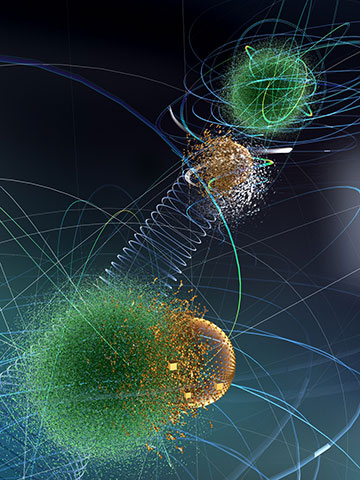
[Image: Courtesy of C.-Y. Lu]
In the second study, a USTC group again headed by Pan and Lu teamed up with researchers at the University of Vienna, Austria, led by OSA member Anton Zeilinger, to look at quantum teleportation. Heretofore, this phenomenon—basically, the transfer of quantum information between two different systems, without physically moving a particle—has been demonstrated only with qubits, simple two-level systems that carry “2-D” information on a single quantum parameter or degree of freedom.
Taking teleportation to higher dimensions could, in principle, allow the transfer not just of one quantum degree of freedom, but of a particle’s complete quantum state. Such a development would substantially boost the amount of information that could be shunted along in potential quantum communication systems and computers. But teleportation of such complex, higher-dimensional quantum states has been an elusive goal.
The further adventures of Alice and Bob
The USTC–Vienna team has now pushed the demonstration of teleportation up one dimension, via a clever setup. First, a 3-D, maximally entangled photon pair—a pair of qutrits—is created, using an ultraviolet pulsed laser and a nonlinear crystal. The photon pair is shared between the transmitter (named, as always, “Alice”) and a receiver (“Bob”). Then, a third qutrit—the “teleportee photon”—is created at the Alice end, and interfered with Alice’s half of the entangled pair.
Conceptual scheme for teleportation of a “qutrit” of 3-D quantum information. Alice and Bob share a maximally entangled 3-D quantum state (photons b and c), and then Alice uses a multiport beam splitter to interfere her half of the entangled state with a “teleportee” photon (a) and an ancillary photon (x). The pattern of detector clicks gives the result of a high-dimensional Bell state measurement on the interfered photons; that click pattern is transmitted over a classical channel to Bob, who performs a unitary transformation (U3) on his photon to recover the original state of Alice’s teleportee photon. [Image: Reprinted with permission from Y.-H. Luo et al., Phys. Rev. Lett. 123, 070505 (2019); copyright 2019 by the American Physical Society] [Enlarge image]
Alice then conducts a Bell-state measurement on the entangled and teleportee photons, with the result encoded as a pattern of clicks in different detectors. Alice next classically transmits the click pattern to Bob; if the pattern from the teleportee photon matches up with that of Bob’s entangled photon, it heralds teleportation of the 3-D quantum information.
In lab tests of the system, the team was able to teleport qutrits with a fidelity of 75%, well above what would be expected by chance. And the researchers argue that the setup is sufficiently general to be extended to teleportation of systems encompassing even higher-dimensional quantum information—so called “quNits.” That, they say, opens of the possibility of realizing “the dream of teleporting a complex quantum system completely.”
A quantum gateway to the stars?
While qutrit teleportation and entanglement of distant solar photons both have the flavor of quantum magic, these experiments are no mere parlor tricks. The ability to teleport higher-dimensional quantum information, for example, could provide significant advantages in robustness and efficiency for quantum-key distribution systems for communications, and in the build-out of quantum networks. The ability to achieve quantum interference and entanglement with photons from the sun, meanwhile, opens the prospect of using sunlight as a light source for quantum encryption.
Indeed, the researchers see even larger-scale utility for the solar-photons experiment. The same techniques, they point out, can in principle be used on photons not just from the sun, but from distant stars. That ability, according to the researchers, could afford new opportunities for studying those stars—opening “a new route to quantum optics experiments at an astronomical scale.”

